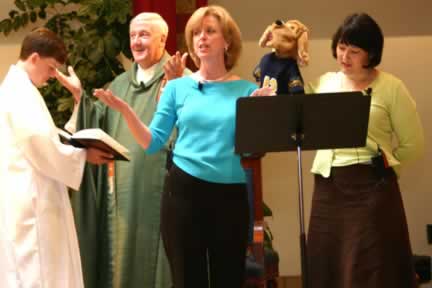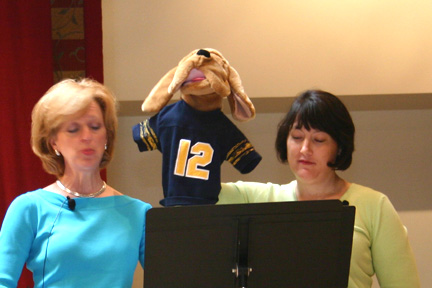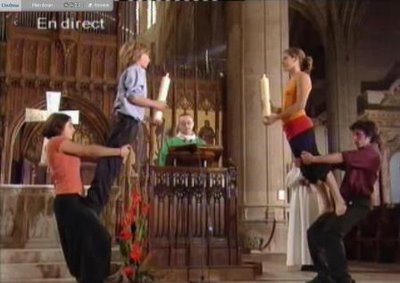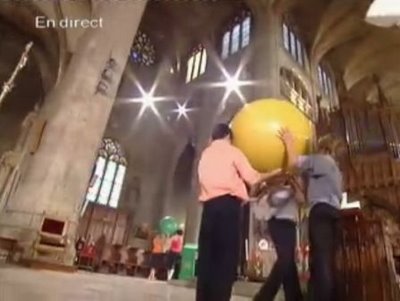An actual nice article on the TLM
in Palo Alto with zero journalist boilerplate we have come to expect on
the subject.
Liturgy
alt=”Ash from Evil Dead”
src=”http://www.splendoroftruth.com/curtjester/wp-content/uploads/2010/02/ash-evil-dead.jpg”>
Well since it is “Ash” Wednesday
src=”http://www.splendoroftruth.com/curtjester/wp-content/uploads/2010/02/capybara.png” height=”253″ width=”300″> |
class=”post”>The capybara kap-i-‘bar-uh, hydrochoerus
hydrochaeris, is a semi-aquatic rodent of South and Central America. It
is the only species in its genus, which belongs to the family
Hydrochoeridae, order Rodentia.
class=”post”>When the Spanish missionaries found the
capybara in Brazil during the 16th century, they wrote to the Pope to
ask – there’s an animal here that’s scaly but also hairy, spends most
of its time in the water but occasionally comes on land; can we
classify it as a fish (and thus, the indigenous people could continue
to eat it during Lent)?. Not having a clear description of the animal
(and not wanting the petitioners to starve), the Pope agreed and
declared it to be a fish.
Marcel LeJeune
href=”http://marysaggies.blogspot.com/2008/01/lent-2008.html”
target=”_blank”>has a good Lent FAQ.
Fr. Philip N. Powell, OP has
href=”http://hancaquam.blogspot.com/2008/02/fr-philips-ten-commandments-of.html”
target=”_blank”>Fr. Philip’s Ten Commandments of Confession
Jimmy Akin has
href=”http://www.jimmyakin.org/2006/03/annual_lent_fig.html”>a
good roundup of Lenten information.
Jimmy also has the
href=”http://jimmyakin.typepad.com/defensor_fidei/2007/02/ash_wednesday.html”>guidelines
for fasting from the Code of Canon Law.
src=”http://www.splendoroftruth.com/curtjester/wp-content/uploads/2010/02/happylent.gif”
border=”1″ height=”145″ width=”200″>
May are spiritual and physical fasting
make more room for
Christ and may we all grow closer to Christ and Have a Holy Lent in
preparation for the feasts of feasts – Easter!
A reader sent me information about St.
George Parish in Baton
Rouge and Dexter. Now you might ask who is Dexter?

You guessed it. Dexter is the
lovable Puppet Dog that is used to explain the Mass and they stop the
Mass for Dexter to weigh in.

The Children’s puppet Masses (two words I
hate putting together) are suppose to be so popular that for one
weekend all Masses will include Dexter the Puppet Dog – at least I
think it is a dog. Do not give what is holy to dogs, unless they are a puppet dog. But hey it must be alright because he has
a cool 12 on his shirt which is so scripturally based. Now
maybe in some wild way you can attempt to justify this for a children’s
Mass, but for all Masses during a weekend? Hey let us get
purple dinosaurs as altar-dinos because wow wouldn’t that be fun and
the children would love it. They could sing little songs
explaining what they are doing. Besides what’s the limit as
long as children are learning something? Besides isn’t the
combination of Mass and puppet – Muppet.
Now puppets used as a teaching tool are
probably a great idea if used in for example the parish hall, but
puppetry and Calvary are a non-starter. Now I grew up in
children’s theater and my father was both an actor and a puppeteer and
I got to help him out at times. So I don’t have
puppetphobia and think in the right setting an explanation of the Mass
using puppets for children could be useful, but not during Mass.
Tommorow is the feast day for Saint John Bosco who was a
juggler, magician, and acrobat and used these skills in his
evangelization effort with children – but does anybody seriously think
that he would ever have considred doing this during Mass? I
think the is more likely have turned his dog Grigio on any puppets
trying to appear at Mass.
My reader informs me that they
have it on good authority that the Bishop of Baton Rouge knows about
this and has no problem with its continued use.
I am starting to wonder if Louisiana is
now the headquarters of the Puppet Mass since a Fr. Sweet in Shreveport
is a ventriloquist who does Mass with his puppet Charlie. I
assume In Persona Puppet.
Update via a commenter:
You say “the Bishop of Baton Rouge knows about this and has no problem with its continued use”. But in fact the pastor was told the day after this occurred (some weeks ago, well before advent) by the chancery that it was not okay, and that it was never to happen again…the bishop’s office was NOT okay with it. Apparently this was the idea of a lay ministry coordinator who doesn’t know much about liturgy at all. The pastor and associate pastor (not to mention most of the parishioners, who were quite properly aghast) were very uncomfortable with it.
Update: People who defend this are blind. First, as a parishioner at this particular parish I’d like to correct some facts. Fr. Mike, our pastor, came to us in November of 2005 so he just celebrated his second anniversary as Pastor. Also, this puppet mass never happened before Fr. Mike was pastor. Last year was the first year this ocurred and this year was the second. It was after this year’s Mass that it was announced that all Masses on one weekend would be puppet masses because of the “popularity.” While some of us are truly outraged to make it look like this has been going on for many years and that the Pastor is trying to weed this stuff out is false. Such things as this, liturgical dance, and other abuses continue to be a problem in our parish and it seems that everyone wants to turn a blind eye.
After seeing the pictures in the post below here are some pictures to
cleanse your palate. Te Deum laudamus! has
some wonderful pictures of a wedding that took place using
the Extraordinary Form of the Roman Rite at the Assumption Grotto in
Detroit, Michigan.
This should make you feell better about the celebration of the Mass at your local parish

I am thinking of starting up a campaign to
donate money to the the
Cathedral of Auch in the Diocse of Gers. Surely their funds
must have run low and couldn’t buy proper candle holders. At
least that is the most charitable explanation I could think of.
Though my charitable imagination fails at
the other pictures in the
series
at Catholic Church Conservation which are not for the liturgical faint of heart.

With the last picture in the series I am
really hoping that the ball
shown is the one from the TV series The Prisoner and in this case is being used to pacify liturgical performers.
There has been a lot of buzz in St.
Blogs over the Pope celebrating
the Solemnity of the Baptism of our Lord using the Sistine Chapel’s
original altar and praying the Mass Ad Orientum. In previous
years a wooden platform was built over the original altar with a
smaller altar placed on it.
Zadok
the Roman has found and example of
highly ironic reporting on this.
In a departure from tradition,
Benedict did not celebrate the Mass at a small altar set up to face the
congregation.
No doubt we are in for a rash of
stories of the Pope turning his back on the people as we got as
journalistic boilerplate in coverage of the Motu Proprio.
Anybody who has read then-Cardinal Ratzinger’s book Spirit of the
Liturgy know precisely the Pope’s view of celebrating Mass Ad Orientum.
Fr. Z. says “I contend that more damage was done by
turning around the orientation of Mass than perhaps any single other
change.” and I am inclined
to agree with him. Facing the people can too easily lead to “Ad
Entertainer.”
Good coverage of this can be found at:
Teresa at Blog by the Sea.
The New Liturgical Movement
Amy Welborn
Hermeneutic of Continuity
I know the following story is a couple of days old, but it is quite good.
VATICAN CITY (CNS) — The reverence and awe of Catholics who truly believe they are receiving Jesus in the Eucharist should lead them to kneel and receive Communion on their tongues, said a bishop writing in the Vatican newspaper."
If some nonbeliever arrived and observed such an act of adoration perhaps he, too, would ‘fall down and worship God, declaring, God is really in your midst,’" wrote Auxiliary Bishop Athanasius Schneider of Karaganda, Kazakhstan, quoting from the First Letter to the Corinthians.
… Bishop Schneider said that just as a baby opens his mouth to receive nourishment from his mother, so should Catholics open their mouths to receive nourishment from Jesus.
"Christ truly nourishes us with his body and blood in holy Communion and, in the patristic era, it was compared to maternal breastfeeding," he said.
"The awareness of the greatness of the eucharistic mystery is demonstrated in a special way by the manner in which the body of the Lord is distributed and received," the bishop wrote.
In addition to demonstrating true adoration by kneeling, he said, receiving Communion on the tongue also avoids concerns about people receiving the body of Christ with dirty hands or of losing particles of the Eucharist, concerns that make sense if people truly believe in the sacrament.
"Wouldn’t it correspond better to the deepest reality and truth about the consecrated bread if even today the faithful would kneel on the ground to receive it, opening their mouths like the prophet receiving the word of God and allowing themselves to be nourished like a child?" Bishop Schneider asked.
What the Bishop says totally resonates with me. Especially considering last weeks feast of Saint Elizabeth Ann Seaton whose path to conversion to the Catholic Church was in part sparked by seeing how people were receiving Communion. I idea of conversions because of Communion reverence observed in the majority of parishes seems quite unlikely.
Let me make a couple of clarifications first. Since I have come into the Church I have always received on the tongue, but don’t have any problem with people receiving in their hands if done correctly. This is a valid option, though most people probably don’t realize that Communion in the hand is not the ordinary means for receiving and required an indult in the United States and other countries. Receiving on the tongue is the ordinary form for receiving Communion. Receiving Communion in the hand though obviously goes back to the first Mass and is attested to specifically by some of the early Church fathers. Saying that though I much prefer receiving on the tongue and the practice of course pretty much preventing people from taking concentrated Communion hosts away from the Church.
As for kneeling when I first came into the Church this was my practice in receiving Communion until the Bishops conference changed the GIRM though an approved adaptation.
The norm for reception of Holy Communion in the dioceses of the United States is standing. Communicants should not be denied Holy Communion because they kneel. Rather, such instances should be addressed pastorally, by providing the faithful with proper catechesis on the reasons for this norm.|
When receiving Holy Communion, the communicant bows his or her head before the sacrament as a gesture of reverence and receives the Body of the Lord from the minister. The consecrated host may be received either on the tongue or in the hand at the discretion of each communicant. When Holy Communion is received under both kinds, the sign of reverence is also made before receiving the Precious Blood.
I realize that if I wouldn’t be denied Communion if I kneeled to receive, but what good is obedience if you are only obedient on what you like. I totally disagree with the USCCB limiting reception to only the norm of standing and I hope this is changed one day to allow the Communicant to choose. They had no problem with reception via the tongue or the hands, so why limit this? But if you are going to set a bow as the norm, then why not a profound bow instead of just the nod of the head?
Ideally I have a much better solution. Let’s bring back altar rails for reception of Communion. The Communion line has become so much like an assembly line with people shuffling to receive like they were in a fast food line. The times I have received Communion at a Communion rail during the TLM have been some of my better experiences receiving Communion. I can first kneel and prepare myself better before receiving Communion and then after receiving I can spend some time in joy and adoration before immediately moving back to the pew. Sure I can partly prepare myself in a Communion line and then spend time in adoration and thanksgiving once I return to the pew, but the find it not the same as receiving at a Communion rail. Postures help us and as I have said before we need those liturgical training wheels to help us. On a practical level the Communion rail is as fast if not faster as a method to giving Communion to everybody in a short period of time.
One of the reasons that Communion rail use after Vatican II went by the wayside is the use of Extraordinary Ministers of Holy Communion and the distribution of the Precious Blood. Though I think the use of Intinction at the Communion rail would be a great idea. Plus you could still use EMHC’s if actually required to help with one side of the Communion rail, but of course you would only need one.
I think the use of the Communion rail really enhances reverence and would make it much more apparent to others how Catholics view the Eucharist. I doubt though that I will see a return to the altar rail outside of the TLM in my lifetime, but I can hope.
Phoenix, Jan. 4, 2008 (CWNews.com) – Church leaders in Phoenix, Arizona, are discouraging Catholics from attending non-denominational services conducted by a suspended priest, the Arizona Republic reports.
Msgr. Dale Fushek, who has been suspended from public ministry by the Phoenix diocese, continues to lead services at the Mesa Convention Center, drawing several hundred participants, the newspaper reports. The flamboyant priest, who gained national prominence as the founder of the LifeTeen program, risks further disciplinary action by defying the terms of his suspension to preach at “Praise and Worship” services.
![]()
Well LifeTeen was never an organization much for obedience considering illicit practices such as gathering around the altar, so this is not exactly a surprise.
Now I understand you can certainly separate a group from its leader, but I have never been a fan of LifeTeen in the first place. The parish I went to with my mother as a young atheist was pretty much a perfect match for what LifeTeen would become when it was established in 1985. This parish had lots of rock music and I sang with a small ensemble in the sanctuary. Looking back I realize now that I sang more religious hymns in my public high school choir than I did at this parish. This entertainment focused parish with two cool priests who could relate to youth did nothing to make me take Catholicism seriously. I just loved to sing and would put up with going with my mother to Mass after she converted to Catholicism because the music was quite secular and there was nothing to bother my atheistic faith. I guess it was the same in some ways for the two priests since they both left the priesthood and got married. This parish also had lots of events, but none of them seemed to be ordered to Catholicism and the year and a half I sang with the parish and participated in some events I knew just as little about the Catholic Church as I did at the start. I have no doubt my mother’s R.C.I.A. was quite low on doctrine since she saw no problem with me as a proudly atheist proclaiming son receiving Communion even though the extent of my religious experience was being baptized in a Methodist church as an infant. To this day I regret all of those Communions I received unworthily.
I think there is a fundamental problem with the concept of LifeTeen in the first place. Customizing the liturgy for an age group is mostly a mistake. Now the Church does have valid Children’s Masses where parts of the liturgy are shortened, but it does not specify that Barney be used in the hymnal. If you are going to have LifeTeen, why not LifeFogey, LifeMiddleAge, etc. A case can be made as Saint Paul said that sometimes milk has to be given before solid food. But surely teenagers are quite open to truth and beauty and you don’t have to musically pander to them. If teens only go to the Mass because of the music are they going to keep going to Mass when the Mass no longer has the music they came for? If you want to train teens to appreciate the Mass, shouldn’t it be for the same Mass they will go to as they get older? When it comes to the liturgy they deserve to be treated as adults.
Now I have no problems with youth groups using secular or for example Christian rock outside of the liturgy with concerts, youth conferences, etc. I just don’t thinks power chords and Calvary are a match. The Holy Sacrifice of the Mass needs reverence and we need music that promotes beauty and reverence and not just an emotional response. I don’t want to be tapping my foot as I enter the eternal sacrifice.
From a CNS article
As for Pope Benedict’s use of older, much taller miters, Msgr. Marini said they are a sign of how the church moves forward in history without ignoring or forgetting its past.
“Just as in his documents, a pope cites the pontiffs who preceded him in order to indicate the continuity of the church’s magisterium, so in the liturgical sphere, a pope uses the vestments and sacred furnishings” of previous popes, demonstrating a continuity in prayer, he said.
Fr. Z posts a great article on liturgical music from Michael Knox Beran at National Review.
But if good music does not always save the soul, bad music never does. When the electric guitar sounds during the Sacrifice of the Mass, the cherubim weep.
I don’t know about the cherubim weeping, but I can certainly shed a tear when this happens and it is not a tear of joy. As someone who plays the electric guitar and who is a certified head banger I never want to hear electric guitar used in the liturgy and think only very rarely that an acoustic guitar can be used in the liturgy properly.

